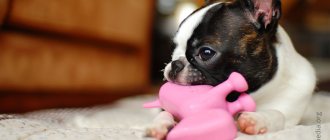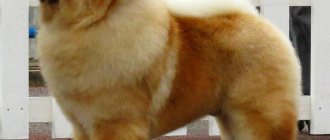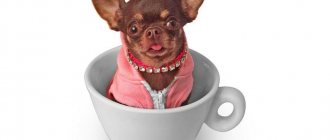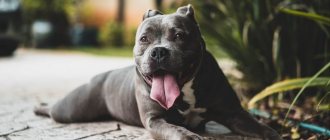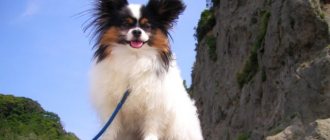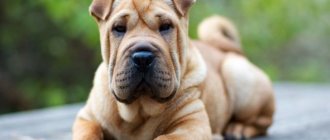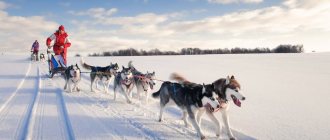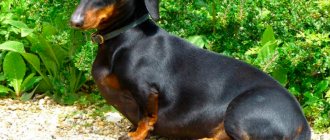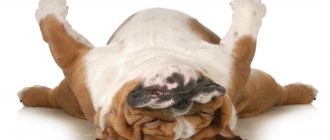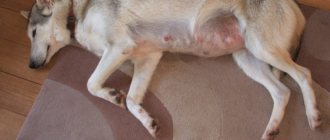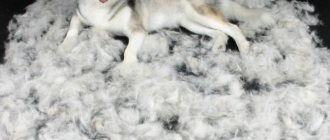This is a difficult question because many dog breeds that may be classified as separate breeds are not recognized by various international kennel clubs and breed registration groups.
However, we can at least give a general estimate, knowing that this will certainly be an underestimate.
The World Canine Organization is best known by its French name, Fédération Cynologique Internationale (FCI). This is the largest internationally recognized dog breed registry. As of this writing, the FCI recognizes 339 dog breeds, which are divided into 10 groups based on the dog's purpose or function, as well as its appearance or size.
Dogue de Bordeaux
A specific feature of the breed is a serious look. However, despite the enormous body weight and wide muzzle, the Dogue de Bordeaux cannot be called an angry dog. Yes, his character is difficult. He often shows stubbornness and resentment, however, this does not prevent the animal from remaining faithful to its owner.
Despite the seriousness in his gaze, this dog becomes very attached to the person raising him, remaining faithful to him throughout his life. With people who treat the Dogue de Bordeaux well, he will be gentle and loving.
This breed is considered one of the most cautious and suspicious. She will never offend her owner and members of his family, but she will also not attack others unnecessarily.
Due to its strong attachment to people living nearby, the dog will prefer to share sofas, beds, and even a table with them. However, you should not spoil such a pet too much. The Dogue de Bordeaux is a very strong animal with short red hair, drooping cheeks, ears and folds on the muzzle.
Dachshunds
Dachshunds are typically hunting, burrowing dogs with a long, strong body and short, thick legs. Considered to be the oldest breed in the world.
There are three types of breed:
- smooth-haired;
- wire-haired;
- long-haired
In addition, they come in standard or rabbit (small) sizes. They are distinguished by a sharp mind and are well trained.
Dachshund dogs are classified as a separate breed group.
With such a huge number of breeds, it is very difficult to choose the best one. Professional breeders work every year to improve existing dog breeds and create completely new ones. Each owner chooses a pet based on personal preferences, and for each owner his dog is the best.
Russian canine
It so happened that in Russia, since ancient times, hunting has been held in high esteem by nobles and landowners. Therefore, it is not surprising that at the turn of the 10th century, almost every kennel had representatives of this breed.
The modern greyhound is a symbiosis of European and Asian elements. The European trait is revealed immediately when looking at the dog, but the Asian trait is expressed in the specifics of its character.
Although admittedly this breed is not one of the fastest, their talent for running at fantastic speed over short distances has been appreciated by many hunters. Running speed can reach 57 km/h.
The Russian dog is characterized by an elegant and narrow body combined with a fairly tall stature. Slightly elongated eyes are located on an elongated head, which is crowned with small, pointed ears that fit tightly to the neck. The presence of a thin and fairly long, saber-shaped tail makes the dog easily recognizable.
Development and consolidation of breed qualities
Previously, the properties of a particular breed were determined mainly by the exterior (appearance) of the dog, as well as its working characteristics. Now, in addition to this, dog handlers have another method - genetic analysis. The DNA of representatives of different groups or one of them is carefully studied and compared, and then, based on this data, dog handlers and breeders plan to consolidate and develop breed properties by crossing different genetic lines with each other.
All this allows you to preserve and develop positive traits, get rid of negative aspects of character and appearance, obtain puppies with the desired characteristics and improve the breed as a whole, as well as create new varieties. Thanks to modern methods, this process occurs much faster than before.
Size division
Groups of dogs are also divided by breed, taking into account their weight and height at the withers. Small dogs fit well into a city apartment, while larger dogs need a full-fledged country house with a designated area.
Dwarf
These babies weigh no more than 4 kg, and their height at the withers does not exceed 30 cm. Dwarf breeds include Japanese Chins, Chihuahuas, Prague Raters, Toy Poodles and Maltese. They live a long time, quickly learn to go to the tray and take up very little space.
Small
The sizes of small dogs are 30-40 cm at the withers and 4-10 kg in weight. They are very friendly, inquisitive and quickly become attached to humans. These include Belgian Griffons, Welsh Terriers, Dachshunds, Pekingese, French Bulldogs and Bologneses.
Average
This group includes the Estonian hound, English cocker spaniel, Karelian-Finnish husky, German pinscher and beagle. The weight of all these animals is 11-25 kg, and the height at the withers is 41-55 cm. Thanks to their developed intelligence and balanced character, they are easy to train and get along well with children.
Large
Large dogs weigh 26-50 kg, and their height ranges from 55 to 75 cm. For this reason, it is better to keep the South Russian Shepherd, Fila Brasileiro, Saluki, Russian Hound, Tosa Inu and other representatives from this group in a private home. Such pets are well suited for home protection and hunting.
Gigantic
The size of the Neapolitan Mastiff, St. Bernard, Irish Wolfhound, Alabai and Caucasian Shepherd is truly frightening. Giant breeds include all animals that exceed the parameters of large ones. These pets will be large even as puppies, so they will need a large area for walking and regular exercise in the fresh air.
“ Top 20 biggest dogs
Classification of dog breeds into groups
If we talk about how many types of dogs there are in the world, then it’s already simpler. All known breeds are classified into several groups.
Small dogs
These include pocket Chihuahuas, charming Bichon Frizes, griffons, which recently became popular in Russia, pugs, Yorkshire terriers and many others.
The main advantage of small dogs is that they are easy to keep in an apartment, they do not need to be walked for a long time (their small paws get tired much faster, so they do not need long distances to waste their energy), and a pack of food lasts them a very long time.
Herding and cattle dogs
In this category, the huge mastiff is adjacent to the Welsh Corgi, because both of these breeds are herding breeds. Only the corgi, from the moment of its breeding, was used for herding sheep, and the mastiff for driving cattle.
In addition to them, the category of shepherds includes all shepherd dogs (the name “shepherd”, which comes from the word “sheep”, speaks for itself), as well as Molossians, for example, Rottweiler, Cane Corso and Great Dane.
Important! Molossers need constant physical activity; it is better not to have such an animal in an apartment.
Molossians are one of the oldest varieties, bred back in antiquity.
Companion dogs, decorative dogs
A companion dog should be friendly, sociable and non-aggressive. Many varieties were initially bred for completely different purposes, but over time they demonstrated the necessary qualities for living side by side with people in houses and apartments.
For example, a dachshund bred to hunt foxes does an excellent job of lying on the sofa next to its owner, while a Scottish Shepherd can become the favorite of a large family and never see a single sheep in its entire life.
Elite types of dogs
The “eliteness” of a breed is most often determined by its price, and the cost is determined based on the dog’s appearance, character and, sad as it is to admit, fashion. For example, after the release of the film “Hachiko,” the price tag for the Akita Inu breed increased sharply, and keeping such a dog began to be considered prestigious.
For a long time, huskies were considered elite thanks to several films and TV series that were released. Currently, the Internet's favorites are in the top: Welsh Corgis, Shiba Inus, Samoyeds, Beagles and Pomeranians.
Primitive type breeds and Spitz
Primitive breeds include dogs that were not bred by man, but domesticated. Almost no selection was applied to them, they were not the result of crossing dogs of different breeds - in fact, they have survived to this day in their original form.
Their most important advantage is that they have good health, live a long time and are almost not susceptible to genetic diseases, because to this day they remain the same as they were formed as a result of evolution.
The main disadvantage is that they are difficult to train. These dogs are smart, but willful, and have their own point of view on everything.
For reference! Primitive breeds include the Chow Chow, Basenji, Akita Inu, Alaskan Malamute, German Spitz and others.
Despite the difficulties in upbringing, the percentage of aboriginal breeds among companion dogs is very high
Beagle dogs
The hound's job is to catch the scent of game and bring it down for its owner. That's why they are called that. Oddly enough, this group of breeds has one of the lowest levels of zoo aggression. Hounds almost never work alone; they are taken out to hunt in a pack.
Problems can only begin if the dog begins to perceive surrounding animals and people as an object of hunting, but this can be easily corrected by education. Hounds are highly trainable and obey their owner unquestioningly. Modern breeds of hounds include beagles, bloodhounds and basset hounds.
Important! Hounds must be socialized from an early age to prevent them from starting to hunt other animals.
Gun dogs
Dogs have a very strong nervous system - they have to work at the sound of gunfire. Cop puppies are taught from a young age not to react to loud noises.
Thanks to many years of selection, these dogs have acquired calmness and obedience, which makes them not only good hunters, but also excellent companions in an urban environment - they obey their owner in everything and almost do not react to stimuli.
Among the cops you can find a golden retriever, a Labrador retriever, a setter, a shorthaired pointer and even a poodle.
Terriers
This is a very large group of breeds, the number of which is constantly increasing. Terriers are united by their purpose - they are dogs that were used to hunt burrowing animals and rodents.
Even the tiny toy terrier and Yorkshire terrier successfully hunt rats and mice. It is easy to identify dogs in this group - almost all of them have the same prefix to the name of the breed.
Greyhounds
Greyhounds differ from hounds in their elongated skull shape, which increases the dog’s angle of vision and allows them to see game in the steppe even at a great distance. In the forest, this ability would be useless, but the birthplace of greyhounds is the Middle East.
The Saluki, or Persian greyhound, is considered one of the oldest breeds in the world, and its image has even been found in cave paintings.
Interesting! Unlike other dogs, the Saluki is considered a pure animal in Islam.
Terriers
Terriers have long been considered ideal burrow hunters. However, among these fearless and intelligent dogs, only decorative pets (Yorkies) are found.
Among terriers, the most widespread are Yorkshire terriers.
The most common and beloved terriers by dog breeders:
- Yorkshire Terrier is a miniature companion dog, fearless, courageous and independent;
- the bull terrier is a real working dog, absolutely insensitive to pain, courageous and sometimes aggressive towards its relatives, but unusually devoted to its owner;
- The German Jagdterrier is considered an irreplaceable dog not only for burrowing, but also for any other hunting, and is distinguished by a difficult, difficult disposition.
Dog's fidelity
- A dog will never betray you and will be a loyal friend to the end.
- Her devotion knows no bounds.
- Will give his life for the owner, sacrificing himself.
Many people think it's instinct. The ancient dog lived in a pack and obeyed the leader. Now she chooses the owner and also obeys.
But that's not true. Not every dog and not every owner will sacrifice itself. A dog will give his life for the one he loves.
- Even during excavations in Pompeii, they found the skeleton of a dog on the skeleton of a child - the dog was covering it with itself.
- Pit bull Zeus saved children from a poisonous snake at the cost of his life.
- The little dog Siko almost lost her eye while protecting her owner’s daughter from a snake.
- Another dog threw himself under the wheels of a motorcycle and saved the owner’s daughter, receiving severe injuries.
Pitbull Lefty from Virginia protected his owner from bullets that burst into the house of bandits. Briton Graham Nuttell died on a mountain walk while walking his four-legged friend. A quarter of a year later, quite by accident, his body was discovered in the mountains. His faithful friend lay nearby, dying of hunger. But he didn’t leave. He died almost immediately after the body of his beloved owner was interred
In honor of the devoted Rusvarp, a monument was even erected in this settlement. In the thirties of the last century, people noticed a dog that was sitting near the entrance to the hospital, waiting for its owner. But, unfortunately, the farmer, her owner, died
His body was sent by train to the place where he was from. His faithful dog accompanied him on his last journey. But he did not think that the owner would not return.
He continued to wait for five whole years without losing hope. During this time, old age came to him, and with it deafness, which became the cause of his death. The dog was hit by a train. Local residents perpetuated the memory of man's faithful friend by erecting a bronze monument to the dog Shepa.
New types of dogs
Different species are being bred every day, which is another reason why it is so difficult to say how many dog breeds there are today. Breeders are constantly experimenting with crossbreeding, producing dogs such as the Labradoodle (Labrador Retriever and Poodle), Pomsky (Pomeranian and Husky), and Shorgi (Corgi and Shetland Sheepdog).
Most of these breeds cannot be called real, no matter how cute they are, because they are not yet recognized by most federations.
The Labradoodle was bred as a hypoallergenic guide dog, and to understand why the Pomsky was bred, you only need to look at them once
Simplified technique
The easiest way to calculate the age of a dog in relation to a person is to take 1 dog year as 7 human years. This technique spread in the middle of the 20th century at the suggestion of veterinarians, who proceeded from the simple ratio that a person lives on average 70 years, and a dog 10.
Due to its simplicity, this rule has become very widespread, but it does not take into account social aspects. A person is actually dependent on his parents for a quarter or even a third of his life - he does not create a family, studies, and learns the norms of morality and behavior in society.
The animal world cannot afford such luxury. So, a one-year-old pet approximately corresponds to 15 years of a person.
A one-year-old pet is already quite capable of performing its work functions.
Comparison of existing pets
In addition to the “official” classification presented above, which takes into account the name and etymology, there are unspoken divisions according to various criteria:
- By size - dogs can be small (weight less than 12 kg, height up to 28 cm), medium (weight 12-25 kg, height 28-60 cm), large (weight more than 25 kg, height from 60 cm).
- Depending on the type of coat, several parameters are taken into account: the degree of hairlessness, hair growth, hair length, hair thickness.
- By hypoallergenicity - the presence or degree of salivation and the intensity of shedding are taken into account here.
- By popularity – the ten most frequently purchased breeds are taken into account. It depends on various factors: convenience, cultural reference, price, etc.
- By purpose - a classification that highlights the working qualities of animals. All breeds can be divided into: hunting, service, companions.
Greyhounds
Greyhounds are bred specifically for hunting and driving game in open areas. The speed they develop far exceeds the running speed of hounds.
Representatives of the greyhound group are capable of developing incredible speeds for dogs.
These unique breeds include:
- Russian Borzoi is a large, vicious and ferocious dog, a real hunter;
- the Afghan hound is a very beautiful, large and strong animal with unusual long hair;
- The Greyhound is the fastest dog in the world, excellent for hunting hares.
Weimaraner
And this is a representative of hunting breeds, whose homeland is Germany. He is well versed in the terrain and has excellent instincts. The Weimaraner tracks game not only by smell, but also by its tracks on the ground. This large breed of dog looks very confident in the photo. It weighs about 45 kg and has a height of 65-75 cm.
The Weimaraner's psyche is quite stable; they are good-natured animals. These qualities make them good companions. However, they do not forgive insults. If you harm a dog once, he will remember it for the rest of his life. The animal has short dark gray or brown fur, very soft to the touch, large eyes and a slightly elongated muzzle.
Since the Weimaraner is a hunter, it needs to be walked for a long time, and at least 3 times a day. Otherwise, he will become sad. He is driven by the instincts of a hunter, therefore, sniffing out game is a priority task for him.
Particular attention should be paid to the animal's nutrition. Remember that food for large breed dogs should be premium, not economy class.
But giving them human food, especially sweet ones, is not recommended.
